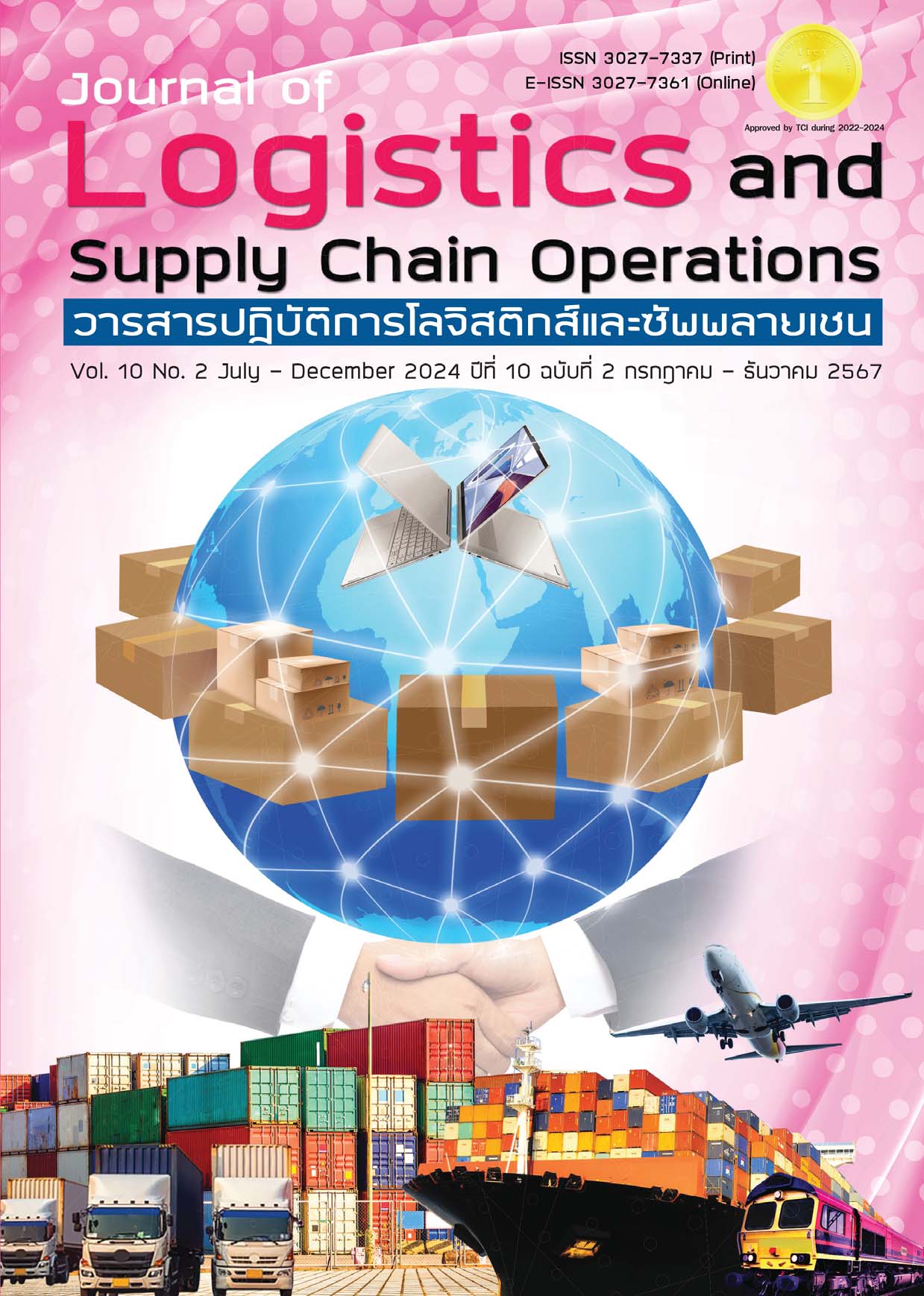The Analytic by Strategic Tools “SWOT- 5 Force Model- Ansoff Matrix -Value Chain” to Design and Develop the Business Model Canvas for the Women’s Career Development Enterprise Group, Pak Kret District, Nonthaburi Province
DOI:
https://doi.org/10.53848/jlsco.v10i2.267265Keywords:
Strategic tools, 5 Force model, Value chain, Business model, Women’s career development enterprise groupAbstract
This research aimed to 1) analyze using the strategic tools that included SWOT, 5 force model, ansoff matrix, value chain 2) design and develop a business model canvas with elements of 9 segments and 3) measure the income increase of Women’s Career Development Enterprise Group, Caring community, Bang Phut sub-district, Pak Kret district, Nonthaburi province using the guideline as the qualitative research methods. Key informants were the members of enterprise group, totaling 20 households together with the use of 20 questionnaires to collect data for analysis. The research tools were SWOT, Five force model, Value chain and Ansoff matrix. Then, the data result obtained from the analysis was brought to design and develop as business model canvas (BMC) to be applied to the Women’s career development enterprise. The research result found that 1) the members of Women’s Career Development Enterprise Group had the expertise to produce the exquisite products, to develop the product designs to be more modern and better, the products are diverse and meeting the needs of customers 2) The analysis result of 4 types of strategic tools could be used to design as business model canvas (BMC) in order to operate the business of the enterprise group well. 3) The result of measuring the income of the enterprise group increased approximately 4,558 baht/month (17.57%). Therefore, the president of the enterprise group should have applied the BMC model of 9 activities to the Women’s Career Development Enterprise Group, It included (1) the customer segment was the government officials or the general public (2) the value propositions were focusing on producing a variety of products, increasing of convenience and comfort in life. (3) channels were the social media and the booth activities at various events. (4) customer relationship was tracking the results from customers and creating a membership system. (5) revenue streams were the wholesale and the retail. (6) key resources were employees, buildings, offices, and machines. (7) key activities were emphasizing the craftsmanship and meticulous works. (8) key partnerships were chaipattana foundation and department of Industrial promotion and (9) cost was focusing on managing the producting cost and the operating cost.
References
การยางแห่งประเทศไทย. (2566). คู่มือการเขียนแบบจำลองธุรกิจ (Business model canvas). พิมพ์ครั้งที่ 1. กรุงเทพฯ: โรงพิมพ์กองบริหารกองทุนและสินเชื่อ การยางแห่งประเทศไทย.
เขมิกา ธนธำรงกุล, ปรีดา ศรีนฤวรรณ ภูษณิศา เตชเถกิง และภัทริกา มณีพันธ์. (2563). โมเดลธุรกิจเพื่อสร้างความได้เปรียบในการแข่งขันของธุรกิจจำหน่ายเครื่องจักรกลการเกษตรในจังหวัดเชียงใหม่. วารสารวิชาการมหาวิทยาลัยราชภัฏศรีสะเกษ, 14(2), 51-62.
จรินทร์ จารุเสน และธันย์นิชา วิโรจน์รุจน์. (2565). การบริหารช่องทางการตลาดสำหรับผลิตภัณฑ์ผ้าขาวม้าบนอัตลักษณ์ชุมชนกลุ่มวิสาหกิจชุมชนคอตตอนดีไซน์ จ.ปทุมธานี. วารสารศิลปการจัดการ, 6(1), 160–174.
จริยา วังเสาร์. (2562). การจัดการห่วงโซ่คุณค่าของมะนาว ในพื้นที่อำเภอแจ้ห่ม จังหวัดลำปาง. การค้นคว้าอิสระปริญญามหาบัณฑิต สาขาวิชาบริหารธุรกิจ, มหาวิทยาลัยแม่โจ้.
จิราพร เมืองพงษา. (2557). กลยุทธ์ทางการตลาดของผู้ประกอบการโชห่วยในกรุงเทพมหานคร. วิทยานิพนธ์ ปริญญามหาบัณฑิต สาขาวิชาธุรกิจระหว่างประเทศ, มหาวิทยาลัยเทคโนโลยีราชมงคลธัญบุรี.
จีรเกียรติ อภิบุณโยภาส และสุขุมาล กล่ำแสงใส. (2563). การส่งเสริมและพัฒนาธุรกิจหมู่บ้านทำมาค้าขาย: กรณีศึกษา วิสาหกิจชุมชนกลุ่มทอผ้าย้อมสีธรรมชาติหนองบัวแดง อำเภอหนองบัวแดง จังหวัดชัยภูมิ. วารสารวิชาการการท่องเที่ยวไทยนานาชาติ, 16(2), 1-21.
ธนภณ นิธิเชาวกุล. (2565). การวิเคราะห์ SWOT analysis กับสถิติ SWOT analysis with statistics.วารสารคุณภาพชีวิตกับกฎหมาย, 18(1), 108-120.
นวัทตกร อุมาศิลป์ และตะวัน ตนยะแหละ. (2564). การพัฒนารูปแบบผ้าทอเกาะยอเชิงสร้างสรรค์: การพัฒนารูปแบบผ้าทอ เกาะยอเพื่อการสร้างตราสินค้าและผลิตภัณฑ์ต้นแบบ. วารสารสังคมศาสตร์และมานุษยวิทยาเชิงพุทธ, 6(12), 529-543.
นิรันดิ์เกียรติ ลิ่วคุณูปการ. (2565). การจัดการห่วงโซ่คุณค่ากลุ่มวิสาหกิจชุมชนผลิตภัณฑ์เกษตรแปรรูป ในพื้นที่จังหวัดชายแดนใต้. วารสารมหาวิทยาลัยราชภัฏยะลา, 17(1), 136-146.
เมทิกา พ่วงแสง และหญิง มัทนัง. (2563). แนวทางการส่งเสริมการตลาดสำหรับกลุ่มวิสาหกิจชุมชนสตรีบ้านบึง ตำบลบ้านบึง อำเภอบ้านคา จังหวัดราชบุรี. วารสารปัญญาภิวัฒน์, 12(2), 55-66.
สุกัญญา พยุงสิน. (2565). การจัดการความรู้ทางการตลาดเพื่อพัฒนาผลิตภัณฑ์แปรรูปปลาช่อนแม่ลาของธุรกิจชุมชนกลุ่มผลิตปลาช่อนแม่ลา จ.สิงห์บุรี. วารสารวิทยาการจัดการปริทัศน์, 24(3), 133-148.
Ansoff, I. (1957). Strategies for diversification. Harvard Business Review, 35(5), 113-124.
Fritz, M. C. M., & Lara-Rodríguez, S. J. (2022). Mercury-free artisanal and small-scale gold mining: Proposing a community-business model canvas. The Extractive Industries and Society, 9(2022), 101039. https://doi.org/10.1016/j.exis.2021.101039.
Mouzas, S., & Bauer F. (2022). Rethinking business performance in global value chains. Journal of Business Research, 144(2022), 679–689. https://doi.org/10.1016/j.jbusres.2022. 02.012.
Porter, M. E. (1980). Competitive Strategy: Techniques for analyzing industries and competitors. New York: The Free Press.



